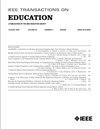作为敏捷软件工程一部分的机器学习教学
IF 2
2区 工程技术
Q2 EDUCATION, SCIENTIFIC DISCIPLINES
引用次数: 0
摘要
贡献:基于行业报告的挑战,在软件工程(SE)和机器学习(ML)的交叉点设计了一种新颖的本科课程。背景:机器学习专业人士报告说,构建机器学习系统是非常不同的,人们需要关于如何将机器学习注入软件生产的新知识。例如,各种专家需要深入参与这些SE项目,例如业务分析师、数据科学家、统计学家和软件工程师。预期结果:创建一个表格,详细说明行业挑战与课程学习目标、课程主题、教学单元和其他相关活动的匹配。应用设计:课程内容来源于对具有相关经验的行业专业人士的访谈,以及对计算机科学与工程专业本科生的调查。所建议的课程风格旨在模拟现实世界中基于ml的SE。发现:经验丰富的IT专业人员证明ML和敏捷SE之间的协同作用正在成熟,现在已经成为标准实践。因此,在SE和ML的交叉点成功地制作了一个试点本科课程的行业衍生内容。本文章由计算机程序翻译,如有差异,请以英文原文为准。
Teaching Machine Learning as Part of Agile Software Engineering
Contribution: A novel undergraduate course design at the intersection of software engineering (SE) and machine learning (ML) based on industry-reported challenges.Background: ML professionals report that building ML systems is different enough that one needs new knowledge about how to infuse ML into software production. For instance, various experts need to be deeply involved with these SE projects, such as business analysts, data scientists, statisticians, and software engineers.Intended Outcomes: The creation of a table detailing and matching industry challenges with course learning objectives, course topics, instructional units, and other related activities.Application Design: Course content was derived from interviewing industry professionals with related experience as well as surveying undergraduate computer science and engineering students. The proposed course style is designed to emulate real-world ML-based SE.Findings: Experienced IT professionals testify that the synergy between ML and agile SE is maturing and now becoming the standard practice. Thus, industry-derived content for a pilot undergraduate course has been successfully crafted at the intersection of SE and ML.
求助全文
通过发布文献求助,成功后即可免费获取论文全文。
去求助
来源期刊

IEEE Transactions on Education
工程技术-工程:电子与电气
CiteScore
5.80
自引率
7.70%
发文量
90
审稿时长
1 months
期刊介绍:
The IEEE Transactions on Education (ToE) publishes significant and original scholarly contributions to education in electrical and electronics engineering, computer engineering, computer science, and other fields within the scope of interest of IEEE. Contributions must address discovery, integration, and/or application of knowledge in education in these fields. Articles must support contributions and assertions with compelling evidence and provide explicit, transparent descriptions of the processes through which the evidence is collected, analyzed, and interpreted. While characteristics of compelling evidence cannot be described to address every conceivable situation, generally assessment of the work being reported must go beyond student self-report and attitudinal data.
 求助内容:
求助内容: 应助结果提醒方式:
应助结果提醒方式:


